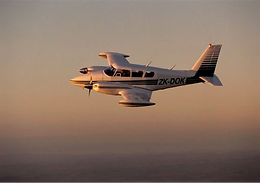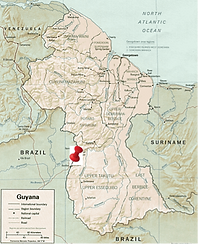
GAMAS AVIATION
GAMAS Aviation
VISION PLAN


Preamble: I remember back in the day that the random dot stereograms were just beginning to come out. I was attending Walla Walla College, and one day I noticed that there was a crowd of students standing around the Administration building. They were all staring at these colorful random dot posters, and oohing and ahhing over what they supposedly saw. So I gave it a try. Nothing... I crossed my eyes. I looked beyond the surface. I did everything they told me to do, with zero success. About the time I was ready to thrown in the towel, and call it nothing but a hoax, it happened... A picture jumped out at me! And then it was my turn to get super excited.
But after having spent the last seven and a half years soaring over Guyana's dense jungles, and beautiful rivers, I’ve been privileged to see and hear that few others have ever witnessed. I praise God for these experiences. Each experience has been a dot of information, that by itself, doesn't have much significance, but when viewed together with other such experiences, forms a beautiful picture of what we need to do, and where we need to go.
This document is just a brief sketch of some of those ideas…
Aircraft: It goes without saying that an aviation program needs airplanes. But what kind of airplanes? there are literally thousands of light airplanes out on the market, and each has a whole differen't set of assets and liabilities. So picking just the right one is sort of tricky.
Our vision is for:
-
2 - Cessna 182’s – The Cessna 182 is a very versatile bush plane, with plenty of power to get in and out of tight jungle airstrips. Our organization has chosen Cessna 182’s for a number of reasons. First of all they are very common on the market, and easy to acquire for a reasonable amount of money. Airplane parts are common, and "relatively" less expensive than other compainies. The airplane is easy to work on, easy to fly, and simple to work on. But most importantly, the Cessna 182 is capable of burning automotive gas, which saves us huge amounts of money.
-
1 - Amphibious 180 or 182 – While Guyana does have a large number of airstrips scattered throughout it’s interior there are many places that are simply inaccessible, except through an amphibious aircraft. Currently, two of our four GAMAS schools are located on two large rivers, but sadly neither school has an airstrip close by.
> An amphibious airplane would allow us to build a sky bridge to these schools, and also open up other river communities that are currently inaccessible.
> This airplane would be a key element in our mission-aviation training program.
-
1 - Long Range Light Twin – Guyana is located on the Northern coast of the South American Continent. With a light twin, we could build a sky bridge over the Caribbean, and connect ministries and projects from the tip of Florida down as far as Bolivia.
> Why fly a twin? The second engine would provide a margin of safety for extended flights over the Caribbean Ocean or the vast uninhabited wastelands and jungles of Brazil.
> This airplane would also be capable of flying to paved airstrips within country, to assist with moving large amounts of supplies to our projects in the field.
Personnel: Perhaps the most difficult task of this vision plan is finding volunteer trainer pilots who are proficient, professional, motivated and visionary.
-
Ideally we’re looking for more experienced pilots who have at least 500 flight hours, with a minimum of a commercial pilots license (CPL) for Single Engine Land (SEL), with an appropriate instrument rating.
-
Ideally we’re also looking for pilots who have mechanical training, with an FAA issued A&P license.
-
Ideally we would like our initial pilots to also have their Certified Flight Instructor rating(s).
Locations: Aircraft location is very critical in this vision plan. By locating our aircraft in three different “hubs”, we will essentially build a strategic triangle. From this triangle we’ll be able to fly almost any location in the country in the country in an hour and thirty minutes or less.
-
Paruima Village: – Paruima Village has been, and continues to be a central hub of activity for our aviation program. It is the location of one of our schools called “Paruima Mission Academy”. Since Paruima Village is located close to the border with Venezuela we can easily purchase and ferry cheap automotive gas into the village. This will provide sustainability out in the field and reduces the need to ferry fuel from Georgetown. It will also help reduce the cost of cost per pound, and over all operational cost, plus provide a quick response time for medical emergencies in the area.
> Our vision is to build a pilot house and hanger at the airstrip, beside our fuel shed so that we can base a pilot family and Cessna 182 full time.
-
Bethany Village: – Bethany Village (Region #2) is a stone’s throw from Georgetown (18 - 20 min. by air) on the west side of the river mouth of the Essequibo River. Bethany Village is also the location of one of our schools called “Bethany Medical Missionary College”. Currently we have an airstrip there, and an unfinished pilothouse, and aircraft hanger.
> Our vision is to complete the pilot house and hanger, so it can be a major flight operation center, and maintenance center as well.
> Build a second house for another pilot, mechanic, or trainee family.
> Pave the airstrip so that a light twin and amphibious aircraft with small tires could easily take off and land.
-
Lethem: – The third area we would like to base an aircraft out of is in the vicinity of Lethem. Lethem is a town of about 4000 people, with small satellite communities scattered around the adjacent Savannah. Lethem provides many advantages. It has electricity, cell phone coverage, and easy access to supplies, groceries and most importantly gasoline. While the cost of living is somewhat higher than Georgetown, the strategic significance far outweighs any negative. Lethem is the gate way town to open up the “Deep South” of Region #9
> Our vision is to build a pilot house and missionary training center so we could systematically reach with aircraft or bush truck, any location from the “Deep South” all the way up to Region #8.
Mission Pilot Training: It has often been said that success without a successor is a failure. And organizations that don’t think about intentional leadership, may flourish for a short time, but eventually it will wither and die. This we must avoid at all costs.
At one point in the late 1970's the Seventh-day Adventist Church had the largest denominationally run mission aviation program in the world. Today it is just a fraction of what it once was. To build back mission aviation in the Adventist Church is one of our primary goals.
At this particular time there is no Adventist Organization (that I know of) that provides systematic, on-going missionary pilot or maintenance field training.
So our vision is to try to fill this need through our new Mission Aviation Training (MAT).
Time Frame: It's a risky thing to write down a time line of when things will happen, because many variables can cause unforeseen delays. But allow me to outline a priority list and a rough time line so that you can see how this can all unfold.
#1 – Our first priority centers around getting the new Cessna 182 (N9113M) completed and safely ferried down to Guyana. This is scheduled to happen around November of 2015.
#2 – In the mean time we’re launching an all out effort to get the materials ready to build the new pilot house at Paruima Airstrip. Since Paruima is so integral to the overall vision, the sooner we can make this pilot house operational, the better.
#3 – Once the Anderson family arrives in Guyana (November) we’ll move our both pilot families out to Paruima Village and stay in temporary housing for about two months. This way we can oversee the construction of the new pilot house and easily and conveniently do our pilot checkout to Region #7.
#4 – Once Todd Anderson is successfully checked out and flying as Pilot in Command (PIC), our family (Ash) will turn our full attention to the Pilot house at Bethany Medical Missionary College (February 2016). We need to dig a well, and put in a water system. The house also needs some significant repairs since the termites have been chewing on it for several years now.
#5 – When the house is livable, we’ll move into it and continue working on the aircraft hanger.
#6 - Several years from now, we plan to focus our attention on Region #9 and developing a complete mission outreach center with our flight base.
Conclusion: As you can clearly see this is not a small vision. We face some momumental challenges in seeing this fulfilled. But we are fully confident that the same God who has led us this far, and has put this vision in our hearts, also has all the resources necessary to fulfill all of this, and perhaps even more!
"The Lord is disappointed when His people place a low estimate upon themselves. He desires His chosen heritage to value themselves according to the price He has placed upon them. ...and He is well pleased when they make the very highest demands upon Him, that they may glorify His name. They may expect large things if they have faith in His promises."—The Desire of Ages, 668.







